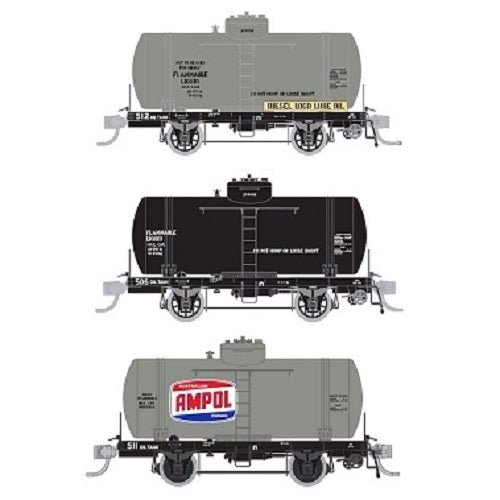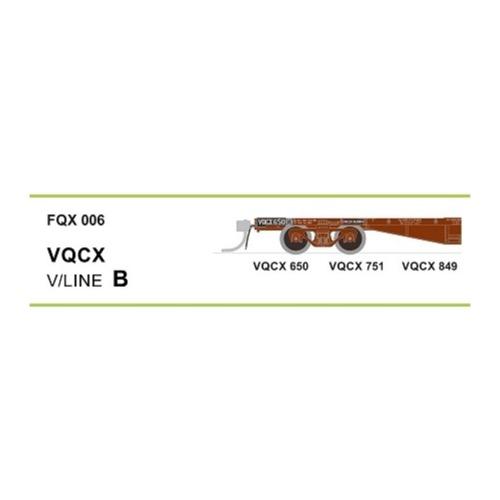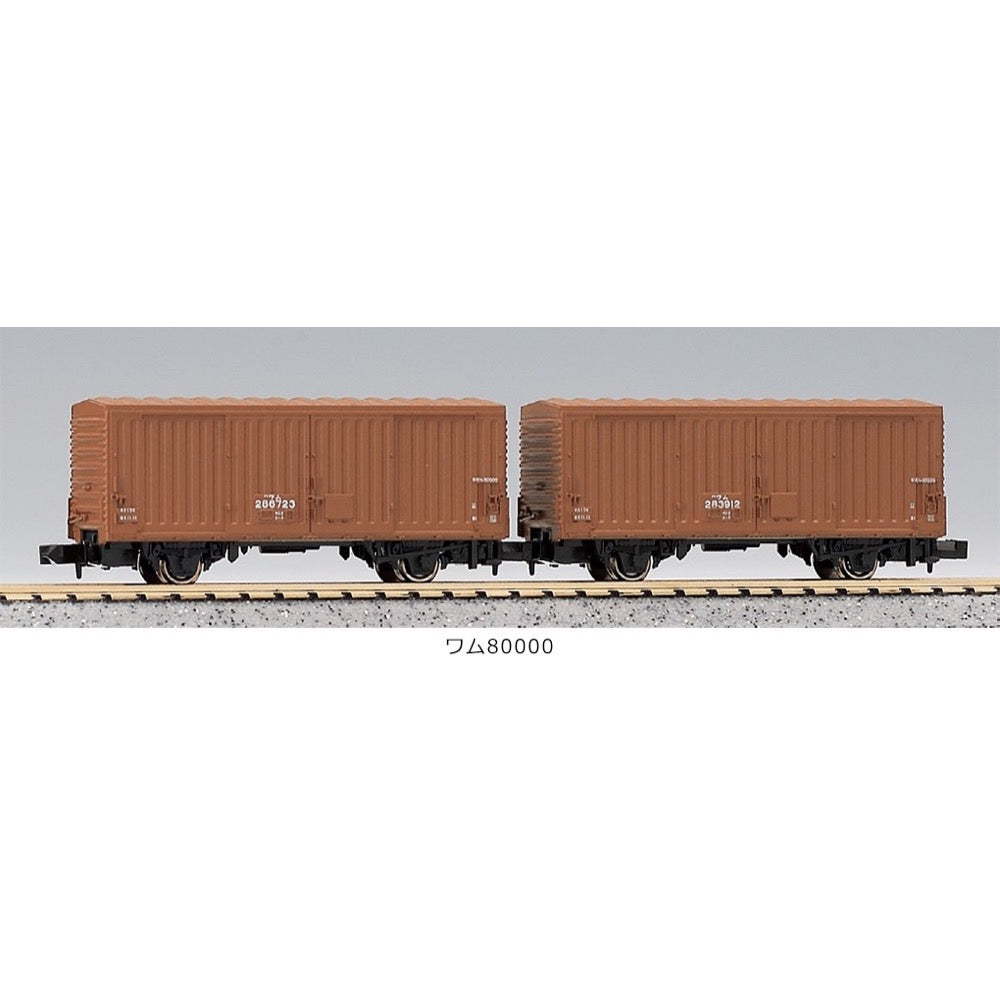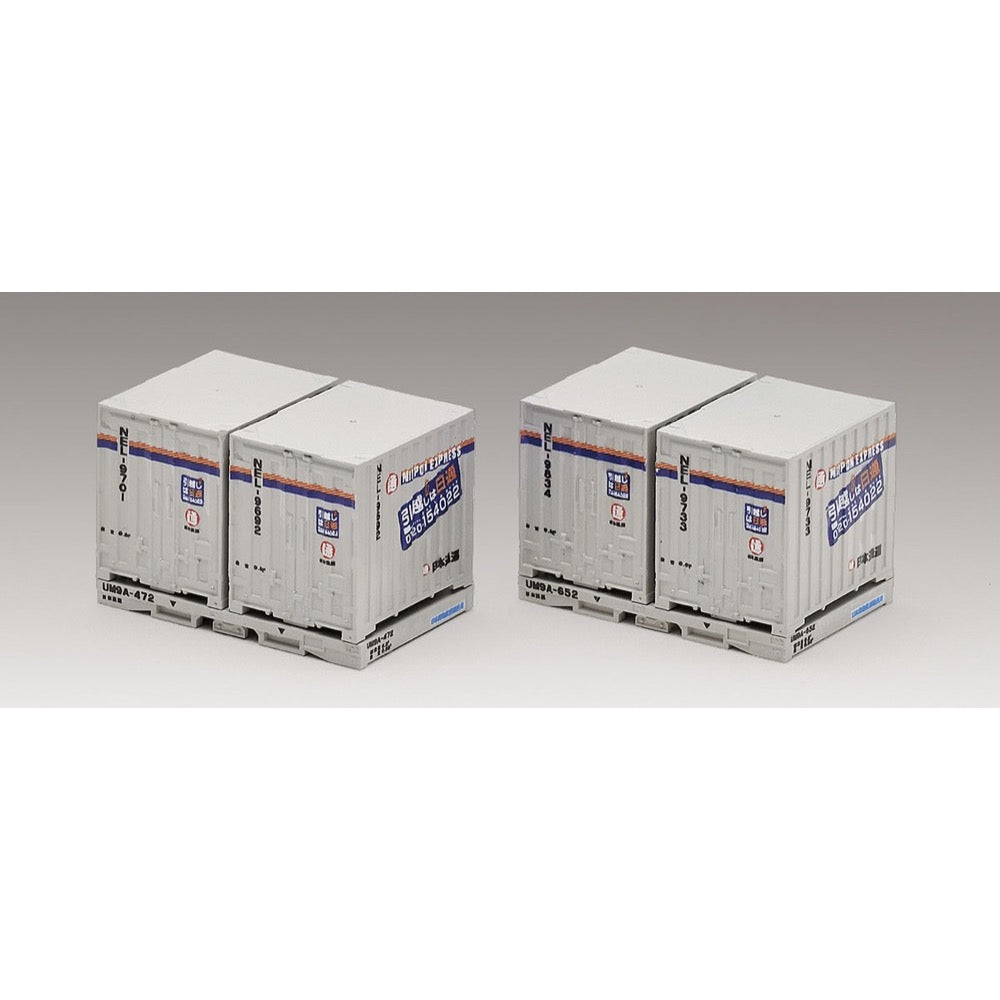
Tomix 3145 N 3145 NEL.UM9A Nittsu New Color
9.00
$
<p>The NEL container is a 6-foot container originally made by Nippon Express that opens on both the front and sides. When loaded onto a container freight car, two containers are placed on top of a UM9A frame. It is used between 32 bases nationwide and Korea.</p>
<h3>Features</h3>
<ul>
<li>Nippon Express original container</li>
<li>NEL container and UM9A frame can be separated</li>
<li>Reproduces the current "Moving is Nippon Express" color</li>
<li>Container logo and number are printed</li>
<li>Numbers are different on both the container and frame</li>
<li>UM9A can be loaded onto a container freight car with one touch</li>
</ul>
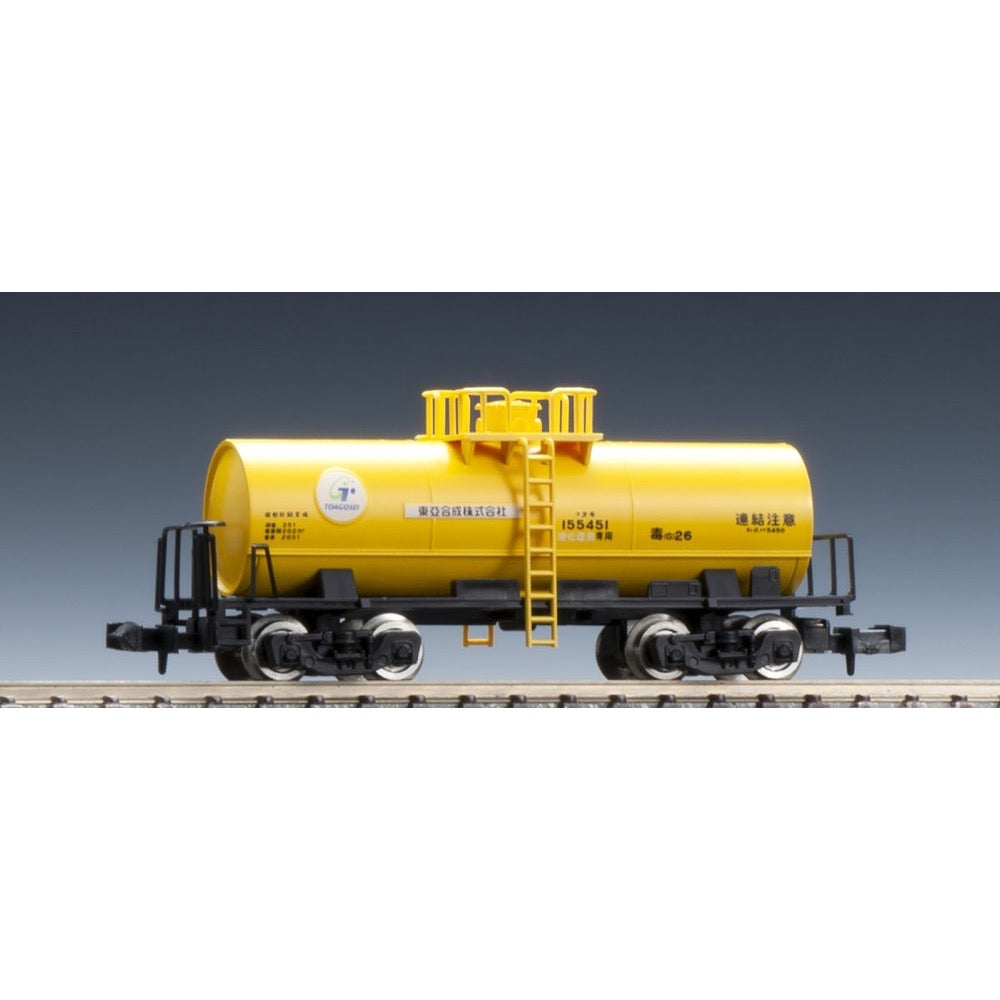
Tomix 8739 N 8739 TAKI 5450 Toa Gosei
9.00
$
<p>The Taki 5450 type is a 25-ton tank car dedicated to liquid chlorine, and by 1994, over 600 cars had been produced. The later group had modified bogies and the depot brakes changed from side brakes to hand brakes. Cars suitable for rail ferry transport had sealed hatches and liquid caustic soda boxes installed, and were marked "(for sea transport)", but after the ferry was abolished, the "(for sea transport)" markings were removed. Toagosei's Taki 5450 had its logo and company name changed when the company changed its name from Toagosei Chemical Industry.</p>
<h3>Features</h3>
<ul>
<li>Reproduces the Toagosei owned car</li>
<li>Reproduces the appearance with the "(for shipping)" notation erased</li>
<li>Car number is printed "TAKI 155451"</li>
<li>Regular station is printed with "Showa-cho"</li>
<li>Can run on mini curves</li>
</ul>
<h3>Contents</h3>
<p><strong>Vehicles</strong></p>
<ul>
<li>TAKI 155451</li>
</ul>

Tomix 3311 N 3311 C95 Container 5pcs. Set
15.00
$
<p>The C95 type container is a simple refrigerated container developed for the Japanese National Railways based on the C21 type container, and was introduced in 1978.</p>
<p>It was used even after the JR took over, but was retired due to the introduction of a successor container.</p>
<h3>Features</h3>
<ul>
<li>Reproduces the C95 type container painted white and blue</li>
<li>Can be loaded onto Tomix's Koki 5500, 10000, 50000 types and each container freight car with one touch</li>
<li>Container numbers (C95-148, 217, 222, 321, 577) are printed</li>
<li>Numbers and markings are printed</li>
<li>5 pieces included</li>
</ul>
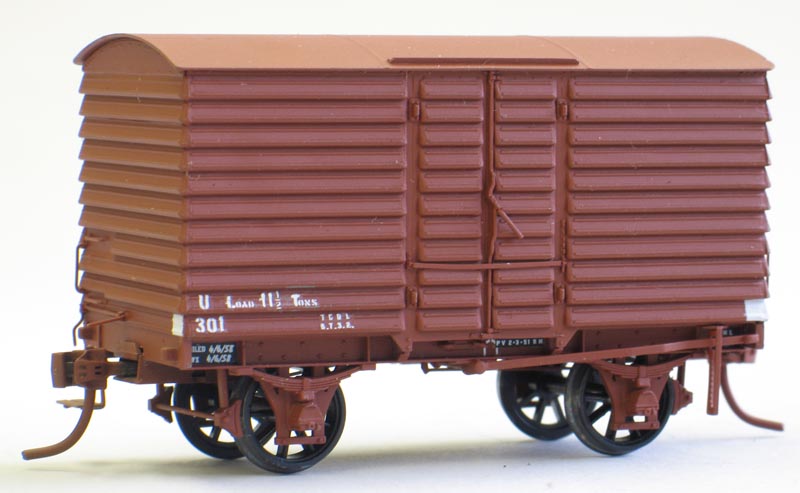
Steam Era Models R30P HO Short Steel U Van Kit without trapdoor
9.00
$
<p>Most rolling stock constructed by or for the Victorian Railways during the 19th century involved significant amounts of wood. Whilst the use of wood allowed savings in initial cost, this was offset by higher maintenance costs in the longer term. Accordingly U 278, the first example of a 10'6” wheelbase louvre van with steel body and underframe, was constructed at Newport Workshops in 1897. Despite the higher build cost of this form of construction, as compared to the earlier series of vans with wooden bodies, it was considered that the projected longer life and reduced maintenance costs justified the construction of further vans to this design. Consequently, a batch of 180 vans, numbered U 281 to U 460, was constructed to the same design between 1898 and 1900. These vans had the handbrake on the opposite side of the van to the brake cylinder and the brake weigh shaft mounted in a plummer block directly below the bottom flange of the side sill. A second batch of 100 vans, numbered U 461 to U 560, was constructed at Newport Workshops in 1906. This second batch of vans had the handbrake installed on the same side of the van as the brake cylinder and the brake weigh shaft was mounted in shallow vee brackets 8 ¼” below the bottom of the side sills. Some vans were constructed with a trap door in the top Louvre at one end and further vans, but not all, were retrofitted with this door.</p>
<p>This kit is representative of a van as running between about 1955, when buffers were removed, and 1978 when the last examples were withdrawn. A number were reclassified as HD, operating in departmental service as tool vans</p>
<h3>Features</h3>
<ul>
<li>
<p>Available in a range of Victorian Railways prototypes of wagons and carriages, in HO scale only.</p>
</li>
<li>
<p>R series kits are injection moulded from polystyrene and RE series kits are etched brass with lost wax brass castings. All kits include instructions, decals and wheels/bogies as appropriate.</p>
</li>
<li>
<p>Kits do NOT include paints, couplers and in many cases etched detail parts, which are all available separately.</p>
</li>
<li>
<p>Wheels to NMRA RP25 code 99 profile and HO gauge, from the standard SEM range of wheelsets, are included.</p>
</li>
<li>
<p>Bogie vehicles are supplied with appropriate bogies and wheels from the standard SEM range.</p>
</li>
</ul>

Tomix 2717 N Wara 1 Wagon
6.00
$
<p>The Wara 1 class freight car was introduced in 1962 and is a typical covered two-axle freight car of the postwar period, with over 17,000 produced.</p>
<p>Highly versatile, it was used in freight trains all over the country, along with a variety of freight cars, in electric, diesel and steam locomotive-pulled freight trains. It</p>
<p>contributed to increasing the transportation capacity of the Japanese National Railways, but was completely abolished in 1987 before the privatization of the Japanese National Railways.</p>
<h3>Features</h3>
<ul>
<li>Newly produced car body and underfloor</li>
<li>Underfloor with a sense of detail due to the reproduction of brake levers and steps</li>
<li>Realistic reproduction of the pressed expression of the car body end and side doors</li>
<li>Various white markings printed on the black exterior</li>
<li>Car number (Wara 2095) printed</li>
<li>Uses silver wheels</li>
<li>Can pass through mini curves (when connected to a locomotive capable of passing through mini curves)</li>
</ul>
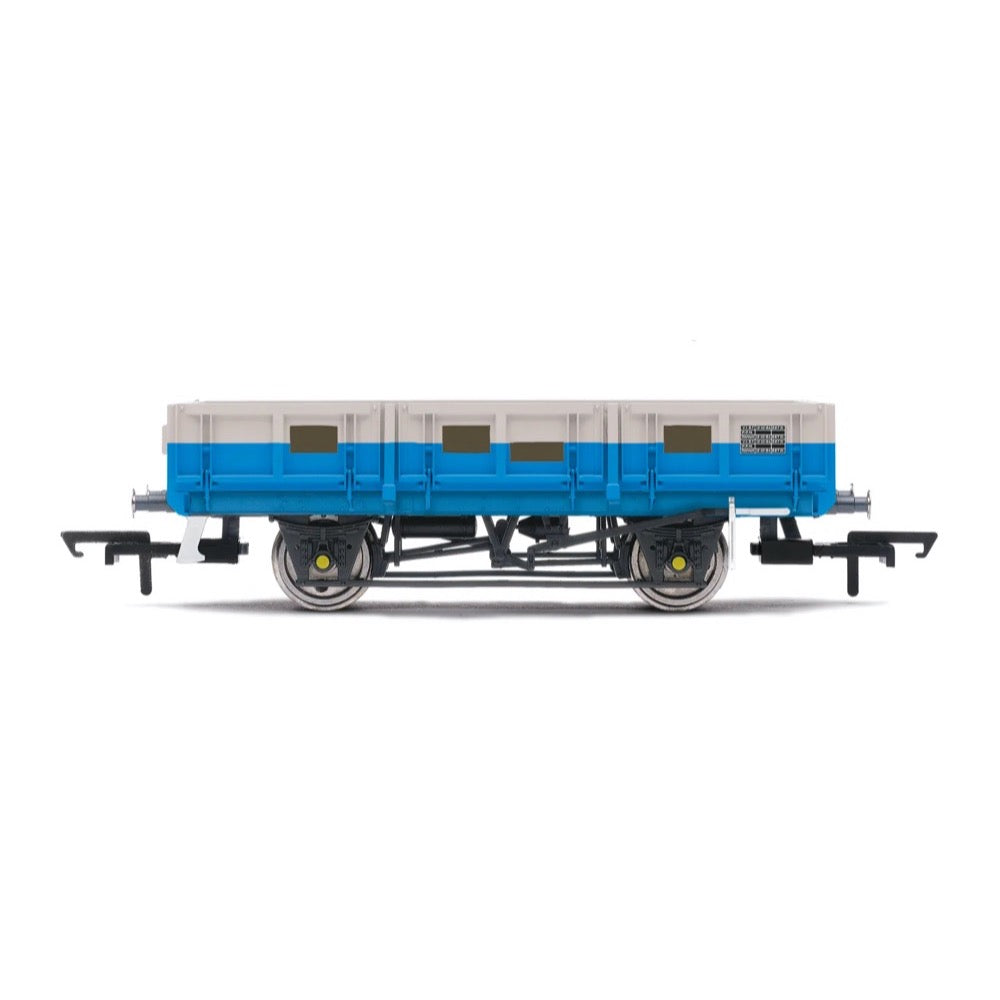
Hornby R60223 OO BR Engineering ZBA Rudd DB972606 Era 8
23.00
$
<p>The ZBA 'Rudd' is a type of low sided open wagon rebuilt from an older HTV type of coal hopper. This rebuild was done on behalf of the BR Civil Engineering department, the department responsible for maintaining the trackwork of the UK.</p><p>The ZBA was the most extreme of these rebuilt wagons with an entirely new body fitted as opposed to having the original one cut down. The first of these rebuilds began appearing in 1984, with the wagons becoming the longest lasting type. ZBA wagons saw their withdrawal come thick and fast around 2008, with their use diminished by advancements in wagon design in the 30 years they were in service.</p><h3>Specifications</h3><ul>
<li>Item Length - Without Packaging (cm): 9</li>
<li>Item Height - Without Packaging (cm): 3</li>
<li>Item Width - Without Packaging (cm): 3.5</li>
<li>Item Weight - Without Packaging: 0.04</li>
<li>Item Scale: 1:76 Scale 00 Gauge</li>
<li>Finish: Painted</li>
<li>Colour: Grey and Yellow</li>
<li>Gauge: OO</li>
<li>Operator: BR</li>
<li>Designer: BR</li>
<li>Livery: BR Engineering</li>
<li>Minimum Curve (mm): Radius 2</li>
<li>Number of Parts: 1</li>
<li>Buffer Type: Sprung Metal Buffers</li>
<li>Coupling Type: NEM Tension Lock</li>
</ul>
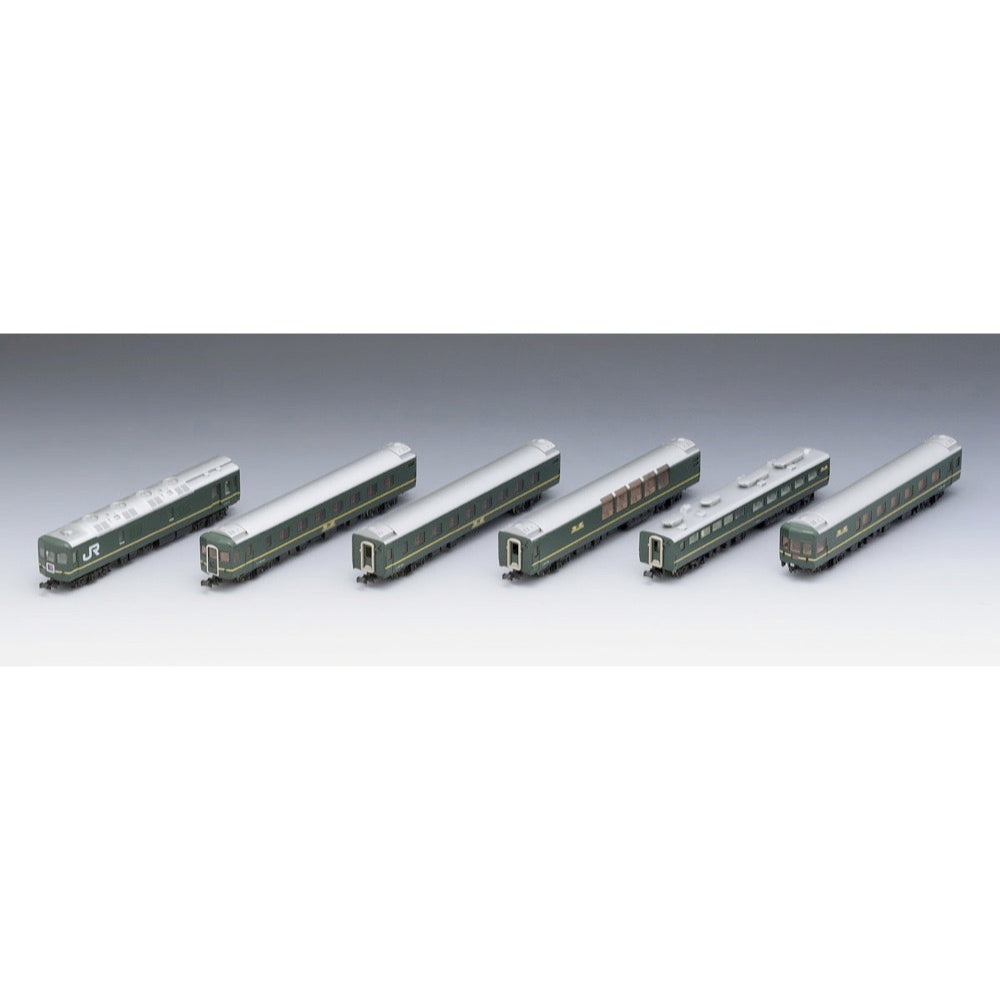
Tomix 98362 N 24-25 Twilight Express basic set B 6cars
92.00
$
<p>The Twilight Express is a sleeper express train that began operation in 1989. It was very popular, with a green color scheme instead of the traditional blue, and luxurious passenger rooms such as two-story private cars, lobby cars, and observation suites.</p>
<p>In addition to the dedicated locomotive EF81, which matches the color of the passenger cars, it also pulled the ED79 and DD51, connecting Osaka and Sapporo until 2015.</p>
<h3>Features</h3>
<ul>
<li>The edges above and below the yellow stripe are reproduced in silver</li>
<li>The bunk bed seats and ladders of the Ohanefu 25-500 and Ohane 25-560 are reproduced</li>
<li>Train markings printed (except Ohanefu 25-500)</li>
<li>Each vehicle body emblem is printed (except Kani 24)</li>
<li>The table lamps of the Sushi 24 light up</li>
<li>The tail lights and train marks of the Slonef 25 and Kani 24 are lit with white LEDs</li>
<li>The tail lights and train marks of the Slonef 25 and Kani 24 are equipped with constant lighting boards</li>
<li>Antenna parts for the Oha 25 are included</li>
<li>Holo frame parts for the conductor's compartment side of the Ohanefu 25 are included</li>
<li>The Ohanefu 25 does not have a light board or train mark printing</li>
<li>The Kani 24 has the JR mark printed on it</li>
<li>The Kani 24 uses seats with engine expressions</li>
<li>The Slonef 25 has a dummy coupler installed</li>
<li>The car number is selectable and a transfer sheet is included</li>
<li>New current collection system and black wheels are used</li>
</ul>
<h3>Contents</h3>
<p><strong>Vehicles</strong></p>
<ul>
<li>Slonev 25-500</li>
<li>Sushi 24</li>
<li>Ohae 25-550</li>
<li>Ohane 25-560</li>
<li>Ohanefu 25-500</li>
<li>Kani 24</li>
</ul>
<p><strong>Accessories</strong></p>
<ul>
<li>Parts (Slonev): Bogie frame with coupler</li>
<li>Parts (Kani): Jumper plug</li>
<li>Parts (Kani): Bogie frame without coupler</li>
<li>Parts (Ohanefu 25-500): Through canopy</li>
<li>Runner parts (Ohae 25): End antenna</li>
<li>Parts (Ohae 25): Jig</li>
<li>Runner parts: Printed head mark</li>
<li>Transfer sheet: Car number, etc.</li>
</ul>
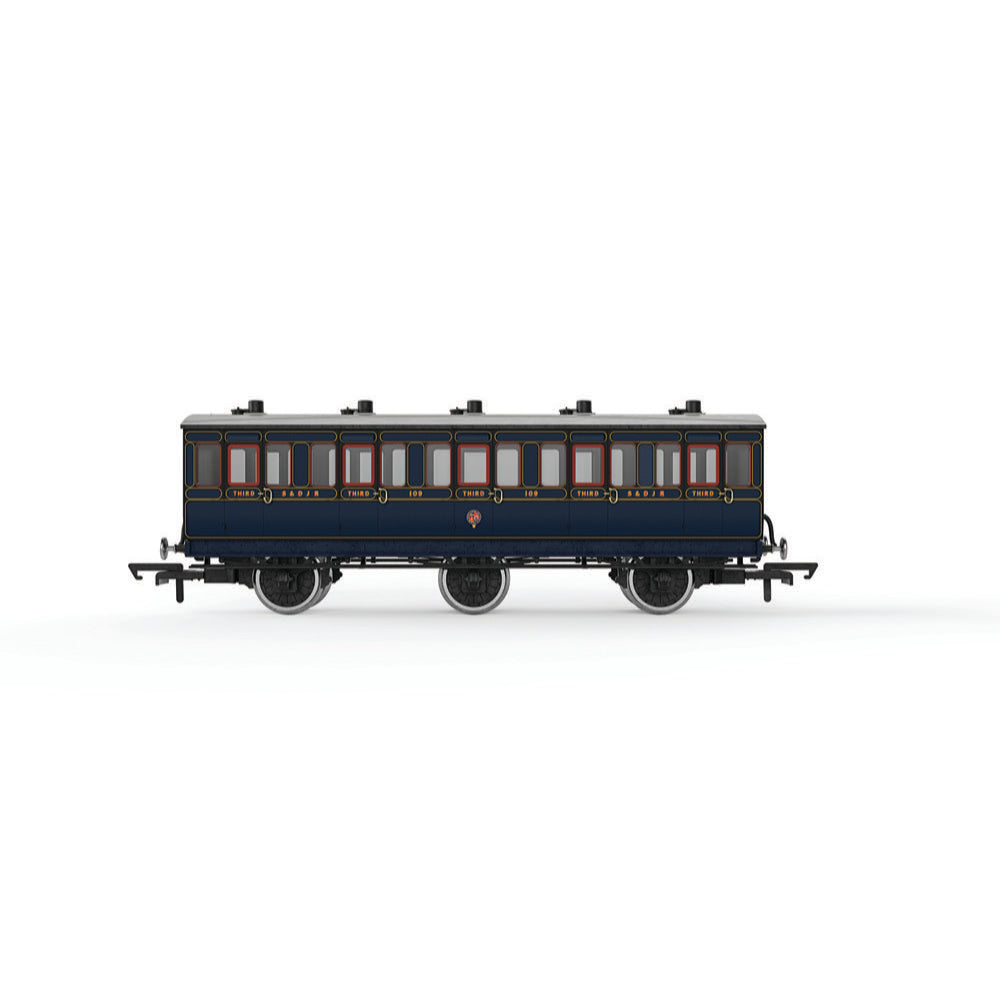
Hornby R40298 OO SandDJR 6 Wheel Coach 3rd Class 109
31.00
$
<p>This 6 Wheeled Coach is a representation of those that ran on the Somerset and Dorset Joint Railway from 1886 until around 1930. After passing to Southern at grouping, many were withdrawn and found themselves re-purposed as houses and sheds.</p>
<p>Small coaches such as this 6 Wheeled Coach proved especially good at branch line work, where their small size enabled them to traverse tight radius curves and be hauled by smaller engines.</p>
<p>This S&DJR coach is modelled as having step boards to enable access at stations with low platforms and electric lighting.</p>
<h4>Include</h4>
<ul>
<li>1x Rolling Stock Coach</li>
</ul>


